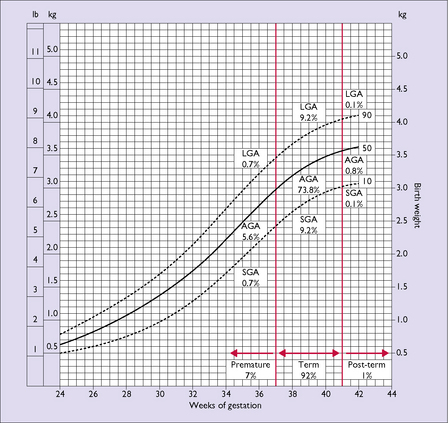Chapter 27 The low-birthweight infant
DEFINITION OF LOW BIRTHWEIGHT
Although the rate of prematurity varies between communities, a common rate in developed countries is 7%, (and that of post-maturity up to 1%). The relation between growth and gestation is illustrated in Figure 27.1, including approximate percentages of the various combinations of gestation and growth relative to the normal parameters. Note that by these definitions less than 75% of babies are born of ‘normal’ gestation and weight. Note also that some LBW infants may be both premature and IUGR.

Fig. 27.1 Birthweight distribution versus gestation period. Dotted lines show the 10th and 90th centiles.
The growth chart illustrated in Figure 27.1 is from an Australian community. It is not necessarily applicable to all communities because of different genetic growth potentials; for instance the birthweights in a population of some Pacific Island groups would show higher growth centiles and some Indian populations would show lower centiles.
CAUSES OF LOW BIRTHWEIGHT
Causes and prevention of prematurity are discussed in Chapter 19, with a summary of causes given in Table 19.1.
The intra-uterine growth of the fetus depends on its inherited growth potential and the effectiveness of the support to its growth provided by the uteroplacental environment. The latter is affected by the presence or absence of maternal disease. The causes of IUGR can be classified according to maternal, placental and fetal causes, and are outlined in Box 27.1. In many cases no precise factor has been identified.



